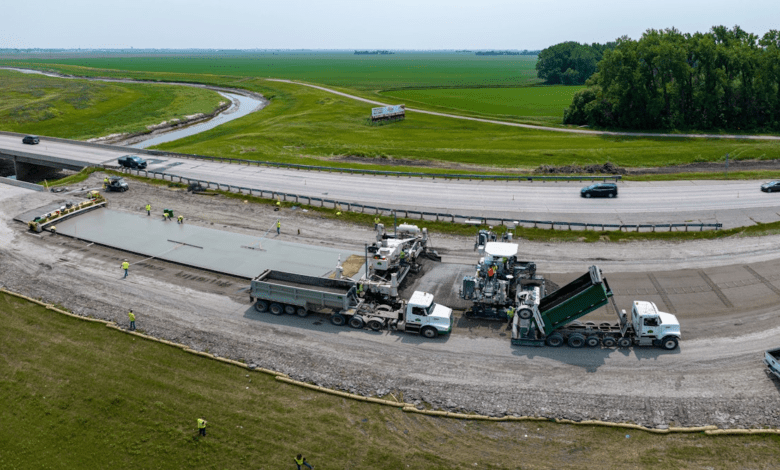Eliminate rework with equipment and technology

We are approaching the halfway point of an election year and road builders, like many others in the construction world, are resisting change. Despite rising materials and labor costs, project managers employ solutions to increase profit margins during this paving season.
The Equipment Manufacturers Association reports rising asphalt and concrete prices and unstable diesel and petroleum prices throughout the rest of the calendar year. Meanwhile, many project managers are still looking for the right person for the job during the ongoing labor shortage. Project managers are left to budget higher salaries for roller operators, table operators and laborers. In addition to increases in business costs, several state or federal projects — as part of the Infrastructure and Investment Laws (IIJA) — require efforts to improve the sustainability of their project proposals. All of these factors have forced equipment professionals, project managers and original equipment manufacturers (OEMs) to identify what will pave the way for long-lasting roads without breaking the bank. The answer for most? Eliminating rework.
Several times in recent years, when John Deere’s leadership team has spoken about the company’s effort to help reduce emissions, it has highlighted its key tactic – reducing rework. After all, not having to turn on your equipment to complete a job a second time means, well, less equipment running and fewer emissions. Construction rework is any unplanned work required as a direct result of errors.
For example, if the width of a concrete paver needs to be redefined because the mix density is wrong or a roller makes too many or not enough passes, the resurfaced road will not have the correct density to meet your specifications. Without achieving the exact smoothness, slope and thickness specified by an engineer, the likelihood of road longevity is low.
Unplanned rework requires additional resources, whether materials, labor or fuel. During this paving season, the focus on financial results, combined with the high demand for sustainable road paving, has led many project managers to update their paving tools.
To enable operators to protect themselves against rework, OEMs like Topcon and Wirtgen offer different technologies and equipment to give entire paving teams a better view of the overall process. From simply extending an operator’s platforms to wireless operation Wirtgen AutoPilot 2.0 control system or highway speed scans to create 3D models, project managers invest in tools so their team has a view of the windshield during each paving pass. See how road construction crews are paving roads accurately, on time and on budget, with equipment and technology.
Choose pavers with versatility
Over the past two years, OEMs have introduced concrete or offset pavers with greater width versatility. With this ability to define the width according to the specific needs of each road, OEMs have also expanded the operator platform. For example, operators say Wirtgen The SP15i platform allows you to view the feeding system, transfer hopper and interior of the mold consolidation compartment. This expanded view and width allows operators to precisely configure the paver for each project and better see their work.

Claunch said his team is more than satisfied with their SP15i compact concrete paver and will still use it on future paving jobs. However, Claunch decided that the benefits of the latest model could make a difference next season.
He said both models have good maneuverability, tight turning angles and flexibility. However, the SP25i can pave roads up to 6 feet 7 inches thick and concrete surface widths up to 12 feet. His team will be paving different cities this year, and he wants to pave according to project specifications based on environmental factors in that region, such as the average temperature, humidity and frost levels.
Where did all the strings go?
This season is a watershed: cordless paving is no longer the anomaly, but is becoming the norm on many construction sites. Project managers say ropeless paving dramatically reduces risks and improves safety. In years past, road builders would stake out ropes so the paver would follow a straight line and compact the concrete to the correct degree and width. Today, sensors and GPS technology accurately guide paving equipment without the need for physical markers.
Northern Improvement Company – a heavy construction, highway and municipal construction company based in North Dakota – has embraced wireless paving. Greg McCormick, president of Northern Improvement, said the company began incorporating the ropeless paving system a few years ago.
In a North Dakota Department of Transportation project, McCormick said ropeless paving significantly improved safety as the crew rebuilt 6 miles of Interstate 94. Without ropes, the crew reduced risks to workers and improved truck efficiency. of transport to deliver concrete, then the WPS 102i concrete placer operated continuously.
Scan roads at highway speeds
When road builders need to ensure their crew achieves the correct compaction rate when quickly repaving a road, they turn to smart paving systems. Last year, Topcon introduced a smart paving system, a 3D scanning, modeling and automated machine guidance system (AMG) to capture a detailed road model using a vehicle-mounted scanner capable of collecting data on live traffic at speeds typical highway.

White and PRS team members fed the engineer’s 3D model, which included the road’s environmentally optimized smoothness, grade and thickness, into five milling machines. Each milling machine was equipped with AMG, a form of automated machine control. The five milling machines simultaneously milled the old road asphalt into a uniform material so that it could be accurately repaved in a single pass. In the end, PRS completed the project in a single weekend, with a 70% increase in road smoothness compared to its previous state.
Early adoption
Road construction teams will likely be the first to adopt equipment and technology to meet the growing demand for durable road construction without increasing material or labor costs. By focusing on eliminating rework, project managers have partnered with equipment experts to empower their operators with a holistic view of the project.
From simple equipment upgrades to complex technological advancements in machine control automation, project managers and operators dramatically decrease machine production time and emissions to pave in a single pass. Accuracy is guaranteed by each team’s dedication to paving the way for the future.




